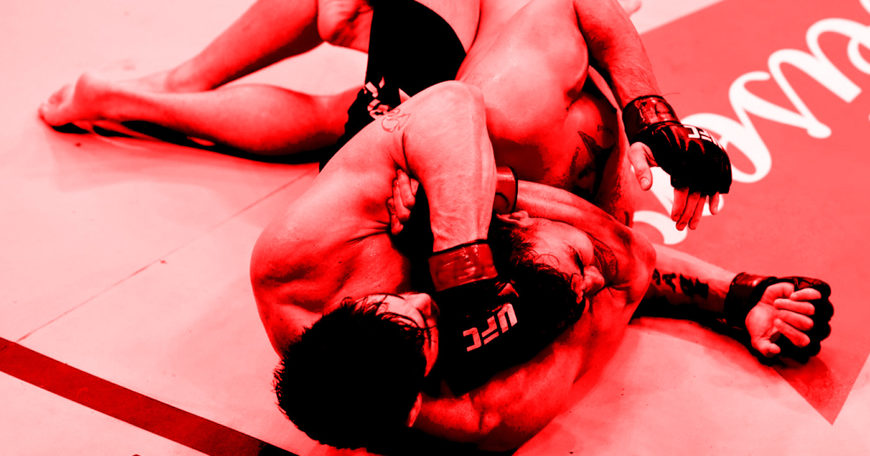Brazilian Jiu-Jitsu is one of the most effective grappling martial arts and one of MMA’s most successful styles. In fact, the UFC wouldn’t be what it is today without the contributions of Hall of Famer Royce Gracie, one of the most influential figures in MMA history.
BJJ is a grappling system based on takedowns, submissions, and ground fighting. While certain ground positions and takedowns do score heavily in MMA and can definitely contribute to a win, the only way to ensure success is by submission. There are a multitude of submissions possible, but the most frequently used are armbars, locks (compression, joint, leg, wrist, etc.), and chokeholds.

Chokeholds, also known as strangleholds, work by restricting air and/or blood from passing through the victim’s neck. Although technically, a chokehold will restrict the air passage whereas a stranglehold reduces the flow of blood in the neck, however, the terms are often used interchangeably. And while practitioners and fighters alike will submit when they can no longer handle the pressure, both techniques can result in a loss of consciousness (and even death) for the victim.
BJJ has about 32 chokeholds or ‘chokes’ that can be used from any position and are a crucial element of the sport. Most chokes will have variations, some of which are compatible both with gi and no-gi, while others are more suitable only with the gi.
This was once true for the ‘spinning baseball bat choke’. Originally only appropriate in uniform, the grip has now been modified to be used without it as well and is the perfect combination of simplicity and effectiveness. In its final form, the hands are positioned in the exact same way they would hold a baseball bat. This is how the grip received its namesake. This choke is one of the most deadly to have in your repertoire, while also being one of the least expected and hard to predict techniques. Despite how powerful it is, the technique and setup are relatively easy, which makes it accessible for beginners and masters alike. There is also plenty of versatility as it can be executed from a variety of positions.
Also considered an advanced version of a cross lapel choke, it is an incredibly fast-acting choke that can put people to sleep very quickly and is notoriously hard to defend because it usually catches the opponent off guard.
Also read: The Ultimate Brazilian Jiu-Jitsu Guide For Beginners
Spinning Baseball Bat Choke: Gi Variation, Top Position
1- Assume side control to start. Reach your left hand under the neck to grab the collar, placing the thumb inside and the fingers on the outside of the lapel (thumb-inside grip). Bring your hand forward to just beneath the ear farthest away from you. You should just be able to see your hand on the other side. Typically, this is not a hard grip to obtain because it is difficult to protect the back of the neck in this position but to ensure it goes as unnoticed as possible, slide the hand flat against the floor in the gap between their neck and the floor.
2- Drive-up into a knee ride. This provides you with different angles to attack from, while simultaneously drawing the opponent’s focus towards the knee, rather than the choke setup.
3- Loosen the collar and place the right hand close to, but just below the left, this time with the thumb inside the gi while the fingers are on the outside (fingers-inside grip). Make sure to use the left hand to push open the gi to create space for the opposite hand to enter (rather than pulling making it harder to get the grip on the right hand). This establishes the baseball grip.
4- Once the baseball bat grip has been secured, the arms should be almost parallel with each other. Proceed to close the right elbow and the left elbow together, this will place the forearms against each other.
5- Maintain this position with the arms and elbows. Now move the feet from the side of the body to take position at either side of the head, like a straddle.
6- Lower the head down to your partner’s stomach, right down the centreline. Pull your elbows towards you, raising the opponent’s head off the floor, tightening the grip, and finishing the chokehold. Alternatively, you can also place your head on the floor by the right hip, preventing their movement. This does change the placement of the feet, however, which will now need to shift towards the left shoulder to secure the choke.
For those that would like to perform the choke without the knee ride, this is also possible. Follow the above instructions from step 1 before taking your right hand under your stomach, and reach to your partner’s shoulder, placing the palm facing up. In this version, you must wait for the opportune time to secure the right hand.
As they move and try to maneuver their own position, slip your hand into the ‘fingers-in grip’ on their lapel as inconspicuously as possible. Proceed with steps 4 through 6 to finish the submission.
Spinning Baseball Bat Choke: Gi Variation, Bottom Position
1-Begin in guard position with your partner. Open or closed is fine. Avoid immediately looking for the cross lapel grip as this will ring immediate alarm bells in their head. Instead, grab the back of the collar on either side of the head, using a thumb inside the grip.
2- Kick out both legs to the side, giving up side control, which is what you want.
3- As they take side control rotate your whole body so that you are almost completely on your side, with you back facing your opponent.
4- Run your feet forwards. As you turn, bring your elbows together in the middle. Your arms should now have formed a cross due to the body rotation.
5- Squeeze your grip downwards to finish the choke.
The baseball choke is an older technique that is thought to have its origins in Judo. For a long time, there wasn’t a no-gi option as the grip is based entirely on the gi’s lapel. Luckily, a solution was created (and is accredited to Scott Sievewright). Although it is a modification to the original technique, it is still a viable option that is both practical and worth learning.
Spinning Baseball Bat Choke: No-Gi Variation, Top Position
Setting up the no-gi choke from side control is relatively easy and is similar to the gi version, as the secret to success is the sneakiness.
1- The no-gi variation calls for a shallow ‘S-grip’. This merely involves hooking the fingers of the right hand (palm up) into the fingers of the left hand (palm down) and securing the grip in that position.
2- Start from side control. Slip your left hand beneath your partner’s neck. Try to do it without them noticing to avoid them defending it.
3- Use your right hand to secure the S-grip and immediately bring the elbows and forearms tightly together. Make sure the right arm is against their neck.
4- There is no need to go North-South like the gi choke, but to finish, it is necessary to adjust your hip position in order to increase the pressure of the grip. To do this, tuck your hip under you, dropping it to the floor where your knee once was (similar to a Kesa Gatame position).
5- Once you lie back, it will lift their head off the floor which tightens and finishes the choke.
Spinning Baseball Bat Choke: No Gi Variation, Bottom Position
1- Begin the setup from knee shield half guard
2- Secure the S-grip around the back of their neck with the left hand on top. Do not put up a struggle to achieve it as it will alert your opponent before you’re able to execute the choke.
3- The real trick here is to allow them to pass the guard without letting them know that this is your intention. Once they do so, raise your shoulders up off the ground like a sit-up, and draw your head forward to meet theirs. Make sure not to leave any gaps where their arm could fit to force space between you both.
4- To finish the choke by applying maximum pressure turn your hips and torso away from your partner.
Conclusion:
The beauty of the spinning baseball bat choke is that when it is set up properly, the opponent doesn’t have much time to react or counter it. There are very few cues that will warn them and only very experienced practitioners tend to be aware of them in advance. In fact, the very nature of the move leads them to believe that they are winning, when in fact they are taking the bait and setting themselves up in a trap.
It’s one of the sneakiest submissions available. Despite that, it is usually not one to be heavily favored. This is in part due to the fact that it is a high-risk, high-reward technique. However, it is incredibly powerful as well as versatile and given that any belt level is capable of achieving it, it is a position worth mastering.









